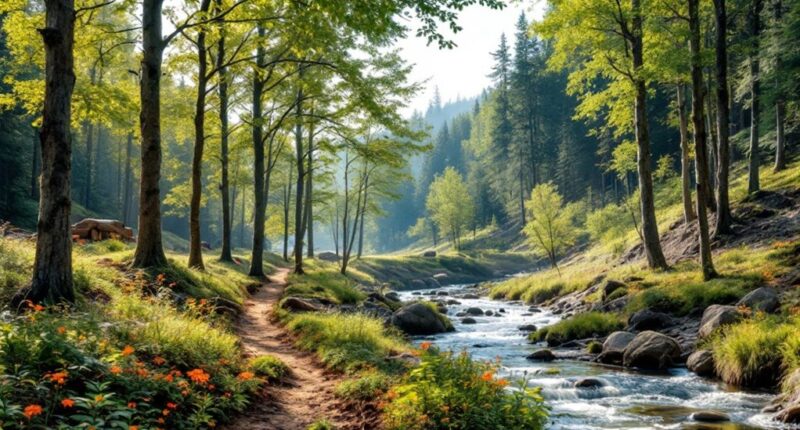Sustainable forestry operates on a three-pillar approach: ecological integrity, economic viability, and social responsibility. It treats forests as complex ecosystems rather than mere timber sources, ensuring we borrow from nature without depleting its capital. Modern practices protect biodiversity, allow natural regeneration, and respect indigenous wisdom while creating alternative income streams like ecotourism. This balanced approach has already transformed nearly 1 billion acres worldwide, proving conservation and use aren’t mutually exclusive goals.

While our forests have silently sustained life on Earth for millennia, sustainable forestry principles now offer a blueprint for their deliberate preservation and responsible use. These interconnected guidelines help forest managers perform a delicate balancing act—treating forests not just as timber factories but as complex ecosystems that serve multiple functions. Think of it as learning to borrow from nature’s bank account without ever touching the principal.
Sustainable forestry operates on a three-legged stool of ecological, economic, and social considerations. Remove any leg, and the whole system topples. The ecological pillar guarantees forests remain biodiversity hotspots, protecting everything from microscopic soil fungi to apex predators. These management approaches create habitat protection zones that serve as sanctuaries for endangered species and ecological communities. Properly managed forests act as natural water filters, carbon vacuum cleaners, and erosion bodyguards—all without charging overtime.
The economic dimension recognizes that forests must pay their way in a resource-hungry world. By harvesting trees at rates that allow natural regeneration (a bit like only spending the interest on your savings), foresters maintain long-term viability. Alternative income streams like ecotourism and mushroom harvesting allow forests to multitask financially without losing their day job of growing trees. Currently, sustainable forestry principles help manage approximately 1 billion acres of certified forests worldwide, demonstrating their growing global significance.
Forests balance their books by yielding what they can spare while nurturing what they need to regrow—nature’s perfect business model.
Social responsibility in forestry acknowledges that humans and forests share a complicated relationship stretching back to our cave-dwelling days. Local communities, especially indigenous peoples, often possess forest wisdom that predates scientific forestry by centuries. The SFI program specifically emphasizes respecting Indigenous rights and incorporating traditional knowledge into forest management practices. Involving these stakeholders in management decisions isn’t just fair play—it’s smart strategy.
Forest health maintenance involves sophisticated pest management approaches and fire prevention tactics. Certification programs like FSC and SFI serve as the forest equivalent of restaurant health inspections, guaranteeing operations meet rigorous standards.
Education forms the final piece of the sustainable forestry puzzle. After all, even the most brilliantly designed management plan fails without knowledgeable professionals to implement it and an informed public to support it. Through training programs and community outreach, sustainable forestry principles continue evolving from academic theory to boots-on-the-ground practice—guaranteeing our leafy neighbors will continue supporting life long after we’re gone.
Frequently Asked Questions
How Do Sustainable Forestry Practices Impact Local Wildlife Populations?
Sustainable forestry practices greatly influence wildlife populations through habitat modification.
Selective logging preserves forest structure while clear-cutting creates new ecological niches. Species respond differently—caribou decline with reduced mature forest coverage, while moose thrive in regenerating areas.
Maintaining dead trees, woody debris, and riparian buffers supports diverse wildlife needs. When properly implemented, these practices balance timber harvesting with biodiversity conservation, creating a mosaic of habitats that can support varied wildlife communities across the landscape.
What Economic Incentives Exist for Landowners to Adopt Sustainable Forestry?
Landowners considering sustainable forestry have a buffet of economic incentives to choose from.
Government programs dish out grants and tax benefits, while market-based options like carbon offsets and certification programs offer premium prices.
Technical assistance programs provide free expertise, and the long-term rewards are substantial – from increased timber quality to diversified income streams.
It’s a rare win-win where ecological responsibility actually pays dividends, making sustainable practices increasingly attractive to forest owners nationwide.
How Does Sustainable Forestry Address Climate Change Concerns?
Sustainable forestry tackles climate change through multiple pathways.
Forests naturally sequester about 16 billion metric tonnes of CO2 annually, while proper management can boost this capacity by 38% by 2030.
Climate-smart practices like selective harvesting and native replanting maintain carbon stocks while producing long-lived wood products that store carbon.
When forests replace carbon-intensive materials in construction, they deliver a double climate benefit—sequestering carbon while preventing emissions from alternative materials.
Can Sustainable Forestry Practices Work in Different Forest Ecosystems?
Sustainable forestry practices can indeed thrive across diverse ecosystems. Each forest type requires tailored approaches: temperate forests benefit from selective harvesting and prescribed burns, while tropical rainforests need reduced-impact logging and community management.
Boreal forests require longer rotation periods and climate adaptation strategies, and plantations thrive with mixed-species planting and integrated pest management.
The principles remain consistent—maintain biodiversity, protect ecosystem functions, and support local communities—but the specific techniques vary with each forest’s unique ecological characteristics.
What Certification Programs Verify Sustainable Forestry Practices?
Several prominent certification programs verify sustainable forestry practices globally.
The Forest Stewardship Council (FSC) evaluates operations using 10 principles across 200+ million hectares.
The Sustainable Forestry Initiative (SFI) focuses on North American forests, covering 360 million acres.
The Programme for the Endorsement of Forest Certification (PEFC) serves as an umbrella organization for national systems, certifying approximately 800 million acres.
For family-owned forests, the American Tree Farm System (ATFS) certifies 19+ million acres using eight sustainability standards.









